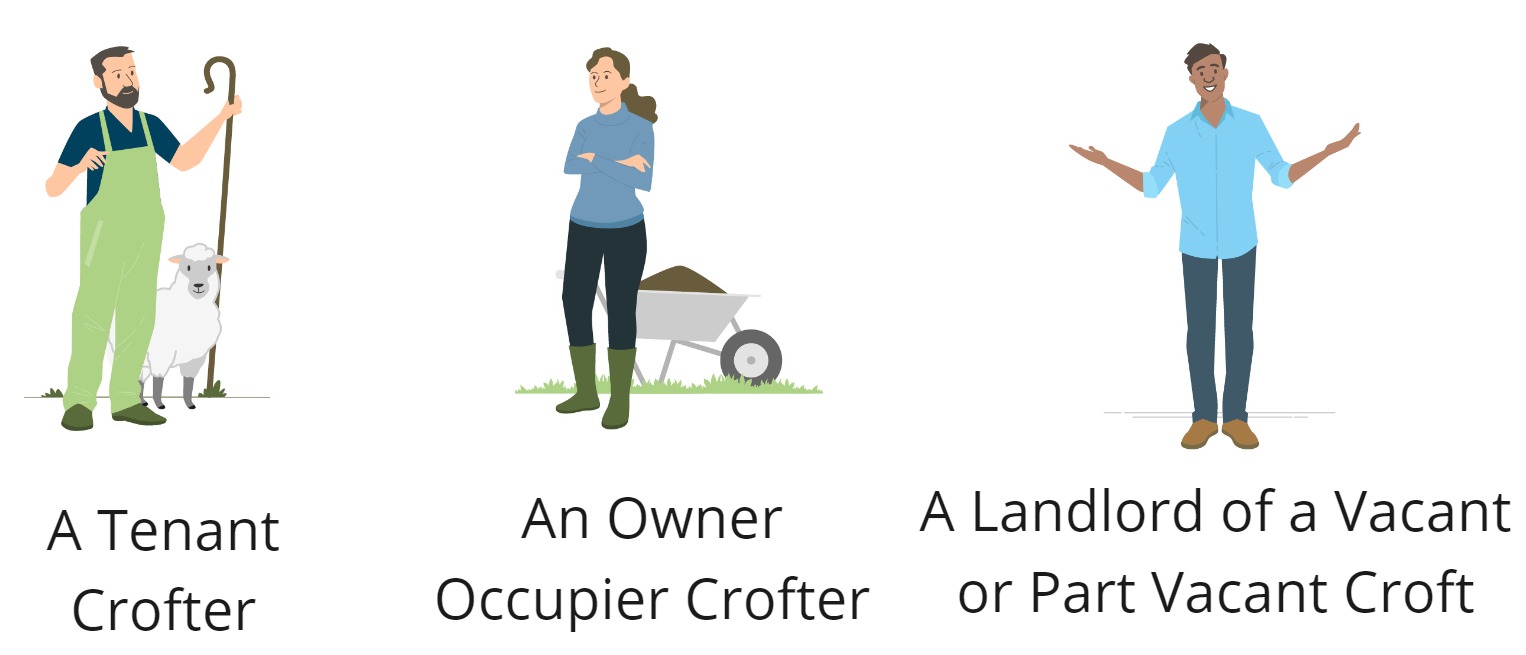
agus ag adhartachadh mathas croitearachd ann an Alba
gus croitearachd a dhèanamh tèarainte san àm ri teachd.
Croft House Site and Garden Ground Decrofting
What is Croft House Site and Garden Ground Decrofting?
Decrofting removes land from a croft, so it is no longer subject to the laws that apply to croft land.
A ‘Croft House Site and Garden Ground Decrofting’ (CHS&GG) decrofting means taking the existing croft house site and garden ground out of crofting tenure. The house must be wind and watertight to apply for this type of application. If it is not wind and watertight, the application should be for a part croft decrofting and you may need to first apply for planning permission to renovate and improve the house.
A crofter has a right to apply to decroft one house as the ‘Croft House Site & Garden Ground’ and any subsequent houses would need to be decrofted using a part croft decrofting application.
Who can apply?

To decroft a ‘Croft House Site and Garden Ground’ the house must be wind and watertight and it must be fit for people to live in.
If you want to decroft an area of land to build a new house on, you need to apply using a part croft decrofting application and include a copy of the planning permission for the proposed new house.
Each crofter is only entitled to apply for one statutory ‘Croft House Site & Garden Ground Decrofting.’ If you have already applied and been granted permission to decroft a ‘Croft House Site & Garden Ground’ on the croft, you cannot apply again using this application.
The area being applied for should not include any buildings that are or can be used for crofting or agricultural purposes. If it does then you should apply to decroft the whole area as a part croft decrofting, or you should remove the site of the buildings from the ‘Croft House Site and Garden Ground Decrofting’ and apply separately to decroft the buildings as a part croft decrofting.
To find the correct form you need, please refer to the form finder.
The Crofting Commission uses a system with ‘parameters’ to decide how to process decrofting applications. Parameters are criteria that the Crofting Commission has agreed on.
If an application meets all the parameters, it is considered to be a ‘straightforward’ application. Straightforward applications can be processed quickly and decided by Casework Officers (this is called a Tier 1 approval).
If an application does not meet all the parameters, it is considered to be a more complex application. Complex applications are decided by more senior staff at the Crofting Commission. Complex applications may take longer for a decision to be taken. For more information on parameters, please refer to ‘How decisions are made on applications.
Some examples of parameters for ‘Croft House Site and Garden Ground Decrofting’ applications include:
- The area being decrofted is smaller than 0.4 hectares.
- There are no other buildings on the land applied for that could be used for crofting/agriculture.
- There is sufficient access to the rest of the croft if the land is decrofted.
- The landlord has not objected to the decrofting application if the croft is tenanted.
If any of these parameters are not met, the application will be considered at a more senior level within the Crofting Commission.
What you need to apply:

- A completeted 'Croft House and Garden Site Decrofting’ Application form.
- Detailed site map of the area being applied for. See the page on Maps for more information.
- Notifications – tenants will need to notify the landlord in writing.
- Registers of Scotland Crofting Register application (more info below on the steps to do this depending on whether the croft is already registered)
Application form
It is important to read the guidance notes both before and as you completed your application. These notes will tell you what information you need to include in your application and what other documents you need to submit.
It is also important to consider the decision parameters when preparing your application.
If the application doesn’t meet the parameters, if objections are received, if there is any inconsistencies between the application and the Register of Crofts, or if the application is not completed correctly it will take longer to process your application.
You can submit your decrofting application online or by post. To access the application for and guidance please use our form finder.
Here is a summary of the key points - Application Form:
- Read the guidance notes before you fill out your decrofting application.
- Consider the parameters when preparing your application.
- You can submit your application online or by post
Registers of Scotland Application
Registers of Scotland hold the Crofting Register, which is a map based register of croft land. If you are applying to decroft land, you will need to either register your croft with Registers of Scotland for the first time, or if it is already registered you will need to submit a form to update the register.
If your croft is not already registered, you need to submit a First Registration (FORM A) application. In this application you will need to provide a map of your croft boundary. This should be submitted alongside your decrofting application form. For details of how to prepare a map of your croft and the correct form please refer to the Registers of Scotland website.
If your croft is already registered, and your decrofting is approved, you need to submit a ‘Subsequent Event’ (FORM B) application. Information about this will be included in the letter you receive from the Crofting Commission informing you of the decision on your decrofting.
You should submit your First Registration (FORM A) or Subsequent Event (FORM B) application to the Crofting Commission. These should be submitted by post. You need to pay a fee of £90 when you submit your application. This can be paid by a cheque made out to the Crofting Commission or bank transfer. The Crofting Commission will check your application and forward it to Registers of Scotland.
Here is a summary of the key points -Registers of Scotland Application
- You need to register your croft land with the Registers of Scotland if you are applying to decroft it.
- If your croft is not already registered, you need to submit a First Registration (FORM A) application alongside your decrofting application.
- If your croft is already registered, you need to submit a Subsequent Event (FORM B) application after the decrofting is approved.
- You need to pay a fee of £90 when you submit your Registers of Scotland application.
- The Crofting Commission will forward your application to Registers of Scotland.
Notifications
Tenants will need to notify the landlord of the application in writing. We require one of the following:
1. The form referred to as ‘Appendix 2A’ contained within the Application form, completed, signed, and returned by the landlord
2. A letter or email from your landlord confirming receipt of notification.
3. Evidence of written notification being sent to your landlord (e.g. recorded delivery receipt).
Once the Crofting Commission have received your completed decrofting application and map, we will check to make sure that you have filled out the correct form and submitted all of the required information. If you have not submitted everything correctly, you will be made aware and will have 28 days to submit the information requested.
If your croft is registered with the Keeper of the Registers of Scotland and meets the parameters, we will try to make a decision on your application within 16 weeks. If your croft is not registered, we cannot make a decision on your application until it is registered. If the application does not meet the parameters, it may take longer, please refer to ‘How decisions are made on applications' for more information.
Here is a summary of the key points:
- The Crofting Commission will check your application to make sure that it is complete and correct.
- The Crofting Commission cannot make a decision on your application if your croft is not registered with the Registers of Scotland.
If the application is approved the Crofting Commission will send you a document called a ‘Decrofting Direction’. This document will only take affect if certain conditions are met.
If you are a tenant crofter the Decrofting Direction will include a condition that you or someone you choose should buy the land that you are decrofting within 5 years. If the land is not purchased the decrofting will fall and the land will remain as croft land. You must let the Crofting Commission know you have bought the land as soon as possible after it is purchased.
If you applied to register your croft on the Registers of Scotland Crofting Register because of your ‘Croft House Site and Garden Ground Decrofting’, the Commission will notify the Registers of Scotland of the 'Decrofting Direction’. If you own the land, then this will be done at the same time as you are sent the ‘Decrofting Direction’. If you are the tenant, the Crofting Commission will do this once they are notified the area of land has been purchased within the 5 years allowed for this.
If your croft is already registered with the Registers of Scotland, to complete your decrofting you need to complete a form called a ‘Registration Application’ called a "Form B" and send it to the Crofting Commission with the £90 payment. The Crofting Commission will process your “Form B” and will send this to the Registers of Scotland to inform that this land no longer forms part of the croft. Further detail on this will be provided in the ‘Decrofting Direction’ and the approval letter
It is important to note that the time limits for completing the Form B and registering the ‘Decrofting Direction’ are set by law, and the Crofting Commission cannot extend them.
The ‘Decrofting Direction’ will take effect on the day that it is registered with the Registers of Scotland. This means that the area of land will no longer be part of the croft on that day.
If your application is refused, you will be informed of the reasons and have the option to appeal to the Scottish Land Court. Please refer to the Appeals page for more information.
Sample-Confirmation-from-landlord-CHS-and-GG.pdf
Sample-Notification-to-Landlord-CHS-and-GG.pdf
law-policy-and-procedure-decrofting-of-croft-house-site-2024.pdf
Leaflet-on-DDM-and-escalating-cases-Decrofting-CHS-and-GG-revised-Nov-2021.pdf
Planning-General-Policy-Response-for-Planning-Consultations.pdf
